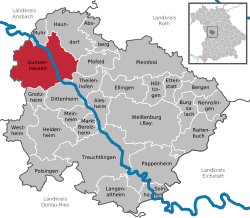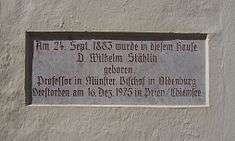Gunzenhausen
| Gunzenhausen | ||
|---|---|---|
|
Protestant St. Mary's Church | ||
| ||
 Gunzenhausen | ||
Location of Gunzenhausen within Weißenburg-Gunzenhausen district  | ||
| Coordinates: 49°06′53″N 10°45′15″E / 49.11472°N 10.75417°ECoordinates: 49°06′53″N 10°45′15″E / 49.11472°N 10.75417°E | ||
| Country | Germany | |
| State | Bavaria | |
| Admin. region | Mittelfranken | |
| District | Weißenburg-Gunzenhausen | |
| Government | ||
| • Mayor | Joachim Federschmidt (SPD) | |
| Area | ||
| • Total | 82.73 km2 (31.94 sq mi) | |
| Population (2015-12-31)[1] | ||
| • Total | 16,432 | |
| • Density | 200/km2 (510/sq mi) | |
| Time zone | CET/CEST (UTC+1/+2) | |
| Postal codes | 91710 | |
| Dialling codes | 09831 | |
| Vehicle registration | WUG, GUN | |
| Website | www.gunzenhausen.de | |
Gunzenhausen is a town in the Weißenburg-Gunzenhausen district, in Bavaria, Germany. It is situated on the river Altmühl, 19 kilometres (12 mi) northwest of Weißenburg in Bayern, and 45 kilometres (28 mi) southwest of Nuremberg. Gunzenhausen is a nationally recognized recreation area.
History
Numerous excavations within the city of Gunzenhausen document that the area was occupied and there was a settlement in pre-historic time. In the year 90 the Romans expelled the Celts, occupied the inhabited areas north of the Donau River and expanded into the Gunzenhausen area. In the year 241 the Alemanni invaded the area and destroyed the fortress. A document from the year 823 supplies the first reliable written reference to Gunzenhausen.
Emperor Ludwig der Fromme conveyed the monastery "Gunzinhusir" to the High-monastery of Ellwangen. Later the "Truhendinger" and the "Oettinger" families became Lords of Gunzenhausen, and in 1368 Gunzenhausen came to the House of Hohenzollern. So the city received the right of holding fairs and was allowed to build city walls, towers and moat, as well as a large church. Gunzenhausen had a big Jewish community and a "Moorish" synagogue, built in 1882; the latter was gradually mutilated during the Hitler regime, and by 1939 the town was declared Judenrein (free of Jews).[2]
In the 1970s eighteen municipalities were combined resulting in the city growing to about 17,000 inhabitants.
International relations
Gunzenhausen is twinned with:
-
 - Frankenmuth, Michigan United States
- Frankenmuth, Michigan United States -
 - Isle, Haute-Vienne France
- Isle, Haute-Vienne France
Local notables

- Andreas Osiander (1498-1552), Lutheran theologian and Christian mystic
- Adam Neuser (c. 1530-1576), Protestant pastor of Heidelberg who held Antitrinitarian views; was imprisoned, escaped, and later converted to Islam
- Simon Marius (1573-1625), astronomer who gave the names to the Jovian satellites Io, Europa, Ganymede and Callisto
- August Richter (1831-1907), Wisconsin businessman and politician
- Wilhelm Stählin (1883-1975), Lutheran theologian, bishop, preacher and one of the major initiators of the Liturgical Movement in German Protestantism in the 20th century

- Otto Willi Gail (1896-1956), science journalist and science fiction author
- Karl Rettlinger (1913-1990), Sturmbannführer (Major) in the Waffen-SS
- Karl Eiden (1917-1987), Leutnant in the Wehrmacht during World War II
- Günter Heimbeck (b. 1946), a German–Namibian retired professor of mathematics best known for his contributions to geometry
References
- ↑ "Fortschreibung des Bevölkerungsstandes". Bayerisches Landesamt für Statistik und Datenverarbeitung (in German). June 2016.
- ↑ "The Synagogue of Gunzenhausen 1882 - 1938" Jüdisches Leben En Gunzenhausen website
| Wikimedia Commons has media related to Gunzenhausen. |

